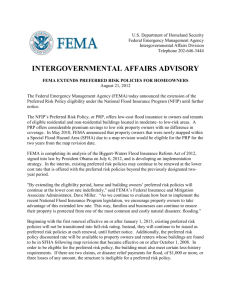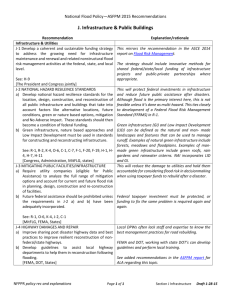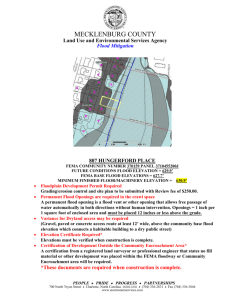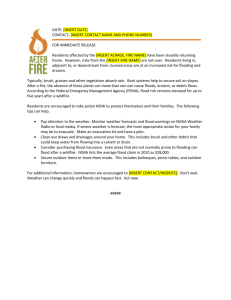Document 7186861
advertisement
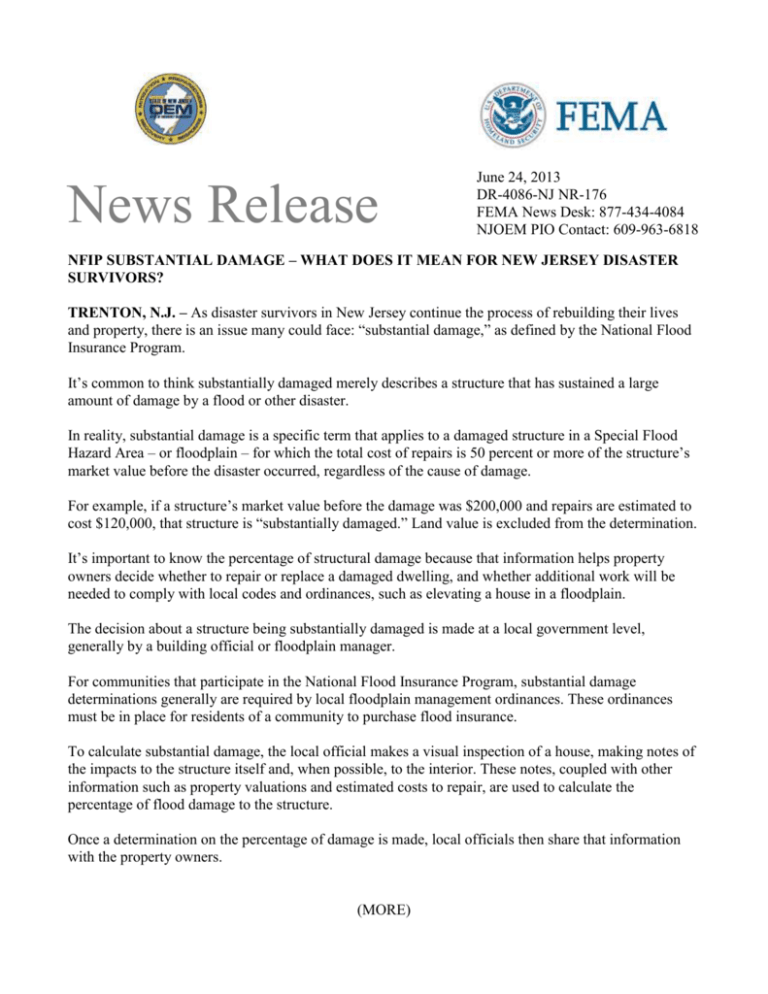
News Release June 24, 2013 DR-4086-NJ NR-176 FEMA News Desk: 877-434-4084 NJOEM PIO Contact: 609-963-6818 NFIP SUBSTANTIAL DAMAGE – WHAT DOES IT MEAN FOR NEW JERSEY DISASTER SURVIVORS? TRENTON, N.J. – As disaster survivors in New Jersey continue the process of rebuilding their lives and property, there is an issue many could face: “substantial damage,” as defined by the National Flood Insurance Program. It’s common to think substantially damaged merely describes a structure that has sustained a large amount of damage by a flood or other disaster. In reality, substantial damage is a specific term that applies to a damaged structure in a Special Flood Hazard Area – or floodplain – for which the total cost of repairs is 50 percent or more of the structure’s market value before the disaster occurred, regardless of the cause of damage. For example, if a structure’s market value before the damage was $200,000 and repairs are estimated to cost $120,000, that structure is “substantially damaged.” Land value is excluded from the determination. It’s important to know the percentage of structural damage because that information helps property owners decide whether to repair or replace a damaged dwelling, and whether additional work will be needed to comply with local codes and ordinances, such as elevating a house in a floodplain. The decision about a structure being substantially damaged is made at a local government level, generally by a building official or floodplain manager. For communities that participate in the National Flood Insurance Program, substantial damage determinations generally are required by local floodplain management ordinances. These ordinances must be in place for residents of a community to purchase flood insurance. To calculate substantial damage, the local official makes a visual inspection of a house, making notes of the impacts to the structure itself and, when possible, to the interior. These notes, coupled with other information such as property valuations and estimated costs to repair, are used to calculate the percentage of flood damage to the structure. Once a determination on the percentage of damage is made, local officials then share that information with the property owners. (MORE) NFIP SUBSTANTIAL DAMAGE – WHAT DOES IT MEAN – Page 2 If a building in a floodplain is determined to be substantially damaged, it must be brought into compliance with local floodplain management regulations: Owners who decide to rebuild may need to elevate their structures, or change them in some other way to comply with those local floodplain regulations and avoid future flood losses. Owners of non-residential structures may need to flood proof their buildings. For more information about how or why a substantial damage determination was made, property owners should contact their local building official. ALL property owners should check with local building officials to determine if permits for repair are required BEFORE beginning the work. Depending on local codes and ordinances, there can be serious consequences for not complying with the permitting process. Property owners who have a flood insurance policy and a substantially damaged building in a Special Flood Hazard Area may be able to use additional funds from their flood insurance policy (up to $30,000) to help defray the costs of elevating, relocating or demolishing a structure. For more information on this provision – also known as Increased Cost of Compliance – contact your insurance agent. For more information on general flood insurance questions, contact your local floodplain administrator, the National Flood Insurance Program (800-427-4661) or your local insurance agent. Information also is available at www.fema.gov and www.floodsmart.gov. Additional information about the coastal mapping efforts and Hurricane Sandy recovery can be found on the Region 2 Coastal Analysis Mapping website: http://www.region2coastal.com. ### FEMA's mission is to support our citizens and first responders to ensure that as a nation we work together to build, sustain, and improve our capability to prepare for, protect against, respond to, recover from, and mitigate all hazards. Follow FEMA online at www.fema.gov/blog, www.twitter.com/fema, www.facebook.com/fema, and www.youtube.com/fema. Also, follow Administrator Craig Fugate's activities at www.twitter.com/craigatfema. The social media links provided are for reference only. FEMA does not endorse any non-government websites, companies or applications.



